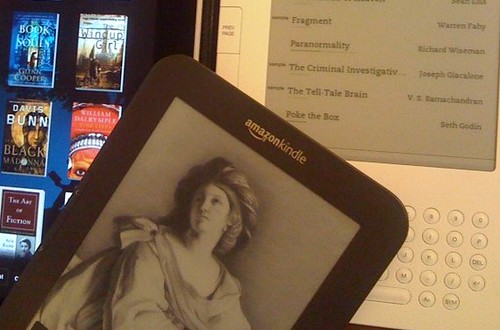I’ve been asked by the Load2Learn team to let people know about their work, especially with BETT coming at the end of January 2013. Load2Learn is a partnership venture between Dyslexia Action and the RNIB. Rather than write what would amount to a page-long advertisement, I thought I’d write a more personal sort of article. I hope you enjoy reading this.
What do you think of when you see the words “reading” and “technology” in the same sentence? I tend to think of e-book readers and how easy it is to transfer stuff to, and then read, on my phone. But there is more to it than that. According to Dyslexia Action, around one in ten students struggle to read standard print.
 Ebook Readers, by Joanna Penn http://www.flickr.com/photos/38314728@N08/
Ebook Readers, by Joanna Penn http://www.flickr.com/photos/38314728@N08/
What does this feel like? The closest I have come to that is a few years ago when my mp3 player developed a fault: it wouldn’t start up, and was still under warranty. This is part of the conversation I had with the company’s technical support:
Me: I can’t start my mp3 player.
Tech Support: OK, could you let me know the serial number please?
Me: No. I can’t read it. (It was in a size 4 (at a guess) font, etched into a chrome case. It would have been hard to read even if the font size had been normal.)
Tech Support: Not to worry, Sir. Just switch the device on and you’ll find it in the Settings menu.
Me: But I can’t switch it on. That’s why I’ve phoned you.
It was a most frustrating experience trying to read this completely inaccessible (to me) serial number. (And not made any easier by dealing with a Technical Support person who could only deal with issues if they were exactly as depicted on her flowchart.) In the end I asked Elaine to look at it. Her eyesight is better than mine, but even she struggled. We got there in the end.
I can’t imagine what it would be like having that sort of experience every day. For pupils struggling to read, it is a form of exclusion which prevents them from getting the most out of their time in the classroom. Yet when there is so much we can do with technology now to ameliorate many of the effects of reading difficulties, is there any need for it?
For example, e-book readers all, as far as I know, have the facility to present text in a larger font than is the standard default. You can simple things with document structuring and screen font size, to name but two. There are text readers available, and having looked at some of them on a technology for print technologies training day, the free ones are definitely not as fully-featured as the paid-for ones. As often is the case, you get what you pay for.
But that’s another thing: in my experience, spending on inclusive technology is often the poor cousin of “mainstream” spending. Apart from the fact that that seems to me to be morally wrong, and legally suspect (in England, for example, schools have to meet the terms of the Disability Discrimination Act), it is also unnecessary. Having a range of devices available to meet the needs of students with special education needs – and by “devices” I mean not only hardware but also approaches and techniques like document structuring – is likely to benefit all students. In any case, frustrated students are more likely to be disruptive than those who are not thus disadvantaged.
As you may be able to tell, I have a bit of a bee in my bonnet about all this, so I was delighted to see that Load2Learn has made it to the BETT Awards finals, in the ICT Special Education Needs Solutions category. It will be great if they actually win, but even making the finals is a good achievement.
As I mentioned in the article Heard any good books lately?, Load2Learn are running some free workshops at BETT – see their BETT page for details.

